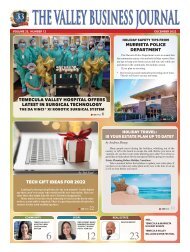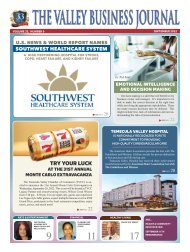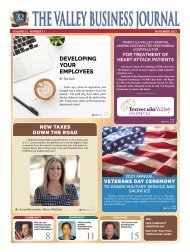March 2016
You also want an ePaper? Increase the reach of your titles
YUMPU automatically turns print PDFs into web optimized ePapers that Google loves.
THE VALLEY BUSINESS JOURNAL<br />
8 www.TheValleyBusinessJournal.com<br />
<strong>March</strong> <strong>2016</strong><br />
Invest an Hour of Your Life to Save the Rest<br />
American Heart Association urges<br />
women to schedule a Well-Woman Visit.<br />
The American Heart Association is<br />
calling on all women to invest an hour of<br />
their life to save the rest by scheduling a<br />
Well-Woman Visit with their health care<br />
provider.<br />
A Well-Woman Visit is a prevention<br />
check-up to review a woman’s overall<br />
health so her doctor can measure blood<br />
pressure, check cholesterol and look for<br />
signs of heart disease, stroke and other<br />
illnesses. It can be scheduled with a primary<br />
care physician, nurse-practitioner or<br />
an Obstetrician Gynecologist (OB-GYN).<br />
A Well-Woman Visit requires no<br />
additional cost for most women because<br />
of the Affordable Care Act. Check your<br />
insurance plan for preventive services coverage<br />
before scheduling a visit. “Getting<br />
to heart disease before it gets to you is one<br />
of the best weapons to fight the nation’s<br />
leading health threats,” said Nicole Or,<br />
executive director of the American Heart<br />
Association in the Inland Empire. “An<br />
annual preventive checkup is a must for<br />
all women. It helps catch health problems<br />
early and minimize damage to the body.”<br />
Cardiovascular disease is America’s<br />
leading killer, but it poses an even greater<br />
threat to women, killing more women than<br />
men every year. Heart disease, stroke and<br />
other cardiovascular diseases cause 1 in 3<br />
deaths among women each year – more<br />
than all cancers combined.<br />
An estimated 44 million women in the<br />
U.S. are affected by cardiovascular diseases.<br />
Ninety percent of women have one or<br />
more risk factors for heart disease or stroke.<br />
The good news is 80 percent of cardiac<br />
events may be prevented with education<br />
and lifestyle changes. In addition to<br />
scheduling a Well-Woman Visit, the AHA<br />
also recommends Life’s Simple 7 as an<br />
approach to improving one’s heart and<br />
brain health.<br />
1. Get active: Aim for at least 30 minutes<br />
of moderate physical activity each day,<br />
five times a week.<br />
2. Eat better: A heart-healthy diet is low<br />
in saturated and trans fat, cholesterol,<br />
sodium and added sugars, and high in<br />
whole grain fiber, lean protein and a<br />
variety fruits and vegetables.<br />
3. Maintain a healthy weight: Bringing<br />
your body mass index (BMI) below 25<br />
benefits your heart.<br />
4. Stop smoking: Breaking the nicotine<br />
addiction is very important if you want<br />
to live a long and healthy life.<br />
5. Manage blood pressure: Keep blood<br />
pressure levels to less than 120/80. Uncontrolled<br />
high blood pressure can hurt<br />
or kill you.<br />
6. Control cholesterol: A cholesterol reading<br />
of 200 mg/dL or higher requires action.<br />
High cholesterol can cause blocked<br />
arteries, which may lead to a heart attack.<br />
7. Reduce blood sugar: Blood sugar levels<br />
above 100 indicate that you may have<br />
diabetes or pre-diabetes, which increases<br />
heart attack risk.<br />
It is equally important to learn the<br />
warning signs of a heart attack. Chest pain<br />
and radiating discomfort in the left arm are<br />
common symptoms for both men and women.<br />
Women, however, may experience other<br />
warning signs, including shortness of breath,<br />
back or jaw pain and nausea. Call 9-1-1<br />
immediately at the first sign of symptoms.<br />
Learn more at www.goredforwomen.<br />
org. To get involved locally, visit www.<br />
iegoredluncheon.org.<br />
Looking Up, or Look Out??<br />
Linguistic master Yogi Berra once<br />
opined, “It’s hard to make predictions,<br />
especially about the future.” That’s<br />
proving to be especially true these<br />
days. In my last newsletter, the Fed<br />
had just raised their interest rate for the<br />
first time in seven years in what was<br />
widely expected to be the first of many<br />
such increases because ‘things were<br />
looking up.’<br />
A scant 30 days later smart money<br />
says the Fed is done for awhile, maybe<br />
quite awhile, as current headlines<br />
trumpet “Big Firms Hit Brake as Profit<br />
Slumps,” “China Bleeds More Cash,”<br />
and “How to Survive the New Economic<br />
Normal.”<br />
The stock market responded handing<br />
the DOW its worst 10 day start to<br />
a year since 1897 in what one senior<br />
trader called “gut wrenching drama.”<br />
Citing fears of further collapse in oil<br />
prices and ongoing weakness in the<br />
Chinese economy, some analysts are<br />
warning of the ‘biggest stock market<br />
crash in a generation.’ Look out!<br />
But before the Bears run amok – the<br />
January unemployment rate dropped<br />
under 5% for the first time in years and<br />
forecaster expect that to drop to the<br />
4.7% rate by year-end. That’s good.<br />
Last year’s forecasters of GDP reaching<br />
the 3% milestone were disappointed<br />
when it averaged just 2.1% and have<br />
tempered their <strong>2016</strong> forecast to 2.5%.<br />
Not great, but better. Housing prices are<br />
expected to rise 4.5% - 5.5% in <strong>2016</strong>,<br />
slightly slower than 2015’s pace, while<br />
new home construction is expected to<br />
reach 1.27 million, its highest rate since<br />
the 2007 route. Things are looking up!<br />
And Alt-A loans, euphemistically<br />
referred to as ‘liar loans’ a decade ago,<br />
are staging a comeback.<br />
That means anxious buyers are out<br />
there but just not that many (yet).<br />
Things are looking up - maybe.<br />
These mortgages, typically extended<br />
to people that can’t fully document<br />
their income, can be a real boon to many<br />
otherwise well-qualified but self-employed<br />
buyers. However, together with<br />
sub-prime loans, they helped fuel the<br />
avalanche of defaults leading up to<br />
the economic crash and thus fell out<br />
of favor. Investors looking for higher<br />
rates of return than current interest rates<br />
are lobbying for these new low-doc<br />
mortgages promising to do a better job<br />
qualifying and policing than before.<br />
Look out - maybe.<br />
January was one heckuva month.<br />
I, for one, was right on the money<br />
when I forecast that January housing<br />
numbers would suck. They did. I’d like<br />
to claim that I’m just that prescient but<br />
you all now that’s not true. It was a pretty<br />
safe call because every January for<br />
the last 5 years has sucked, often being<br />
the lowest sales month of the year.<br />
With December pending sales way<br />
down, it was a sure bet that January<br />
closings would follow suit. That’s too<br />
bad because January’s pending sales<br />
aren’t all that hot either, up only 5%<br />
from December, so February numbers<br />
won’t be anything to brag about even<br />
with an extra day in the calendar. We’ll<br />
have to bide our time until <strong>March</strong> to see<br />
how demand is going to trend this year.<br />
Both sales and median prices were<br />
down in January – sales off 25% from<br />
December and prices down 1%. Even<br />
with that drop, they were good enough<br />
to keep us ahead of 2015, with sales up<br />
10% from last January and prices holding<br />
a 7% edge. Analysts believe prices<br />
will continue to increase this year but at<br />
a slower pace than last year which we’re<br />
seeing borne out in our local market,<br />
With sales down and people starting<br />
to list their homes after the holidays,<br />
inventory ticked up 6%, but still 17%<br />
below where we were last January.<br />
Inventory is holding in that 3 month<br />
range for most cities – new normal. On<br />
average, cities managed to absorb nearly<br />
85% of new listings to the market in<br />
January and homes sold a little faster<br />
bringing days-on-market back down to<br />
an average of 55 days.<br />
That means anxious buyers are<br />
out there but just not that many (yet).<br />
Things are looking up - maybe.<br />
Gene Wunderlich is Vice-President<br />
of Government Affairs for the Southwest<br />
Riverside County Association of<br />
Realtors and Legislative Director for<br />
The Southwest California Legislative<br />
Council. A local advocate on housing<br />
and business issues, you can contact<br />
Gene at GAD@srcar.org or follow him<br />
on Twitter @SWCalAdvocacy.<br />
connect: GAD@srcar.org

















